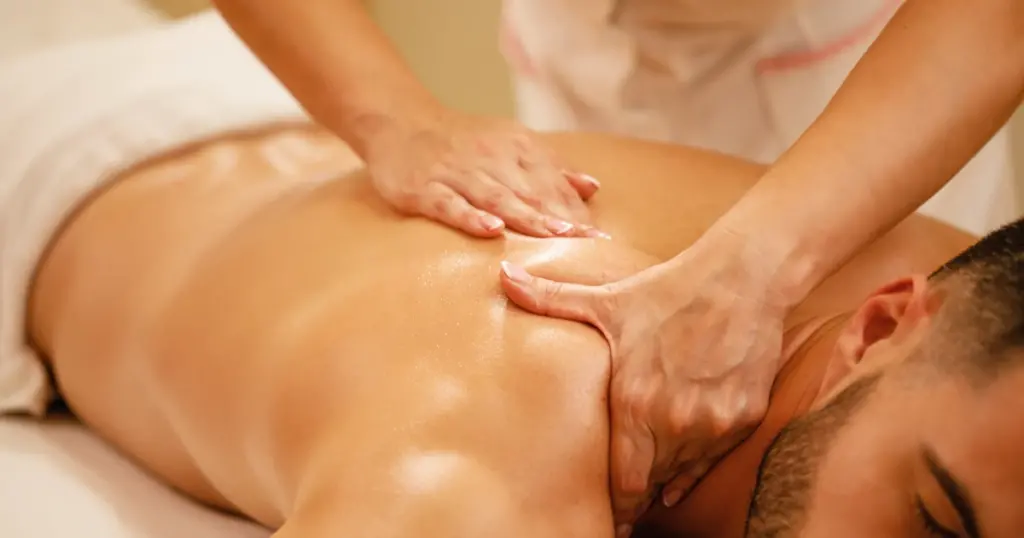Introduction
In the realm of massage therapy, two distinct modalities often capture the interest of those seeking physical and mental well-being: Thai Massage and Swedish Massage. Each has its unique philosophy, techniques, and benefits, making them popular choices for a wide range of individuals. However, the decision between Thai and Swedish massage is more than just a choice of techniques; it’s about understanding the deep-seated traditions, the physiological and psychological nuances, and how these can be harnessed for personalized wellness.
Contrary to common perception, the choice between Thai and Swedish massage isn’t solely about addressing physical discomfort or seeking relaxation. It’s a decision that intertwines with our lifestyle, daily activities, and even our cultural and personal inclinations towards health and well-being. For instance, office workers grappling with the notorious ‘office syndrome’, athletes seeking performance enhancement, or even those engaged in physically demanding tasks like construction work, each find unique relief and benefits in these massage therapies. This aspect often goes unexplored in mainstream discussions about massage therapy.
Interestingly, the choice also reflects a deeper understanding of one’s body. For example, someone who spends most of their day in a sedentary posture might find the dynamic stretches of Thai massage particularly beneficial. Conversely, an individual experiencing high stress might prefer the rhythmic, soothing strokes of Swedish massage. It’s this intimate connection between our daily life patterns and the choice of massage therapy that often goes unnoticed.
Furthermore, the decision between Thai and Swedish massage can be a journey of cultural exploration. Thai massage, with its roots in the healing traditions of Southeast Asia, offers an experience steeped in history and spirituality. Swedish massage, originating from a more Western approach to wellness, emphasizes the scientific understanding of the human body. Choosing between them can thus be a reflection of one’s affinity towards diverse cultural philosophies of health and wellness.
This article aims to delve deeper into these unique modalities, shedding light on their distinctive characteristics, and guiding you towards making an informed decision that aligns with your personal wellness journey. Whether you’re seeking relief from chronic pain, looking to enhance physical flexibility, or simply in need of some well-deserved relaxation, understanding the nuances of Thai and Swedish massage will empower you to make the best choice for your health and happiness.
Understanding Thai Massage
Delving into Thai massage reveals a rich tapestry of history, technique, and healing that goes beyond the commonly discussed aspects in massage therapy. This ancient practice, deeply rooted in the healing traditions of Southeast Asia, offers a complex blend of spiritual, physical, and therapeutic elements that make it a unique form of bodywork.

Origins and Evolution
Thai massage’s origins are as intricate as the movements it involves. Historically, it intertwines with the spiritual and medicinal traditions of ancient India and Southeast Asia. Contrary to popular belief, its development was not just about physical therapy but also about integrating spiritual healing. The influence of Buddhism, for instance, is evident in the meditative aspect of Thai massage, an element often overlooked in discussions about its benefits.
Techniques and Specializations
The techniques of Thai massage are a dance between practitioner and client, a dynamic flow that defies the more static nature of other massage forms. The practitioner uses not only their hands but also their elbows, knees, and feet, to create a holistic movement that engages the entire body of the receiver. This approach is not just about relieving muscle tension; it’s about creating a harmonious energy flow throughout the body, which can significantly impact one’s emotional and mental well-being.
One of the less discussed aspects of Thai massage is its specialization in barefoot techniques. The use of the practitioner’s feet allows for deeper pressure and a broader range of movement, offering a unique experience that can be particularly beneficial for those with deep-seated tension or larger body types.
Health Benefits
While the physical benefits of Thai massage, such as improved flexibility and pain relief, are well-known, its impact on mental health is not as widely recognized. The meditative quality of Thai massage can induce a state of mental clarity and calmness, akin to the effects of a deep meditation session. This aspect is particularly beneficial for those dealing with stress, anxiety, or mental fatigue.
Additionally, Thai massage’s approach to treating office syndrome – a condition prevalent among office workers due to prolonged sitting and computer use – is unique. By focusing on the neck, head, hands, and arms, Thai massage addresses the specific pain and tension patterns that develop in this demographic, offering a tailored solution that goes beyond general pain relief.
In conclusion, Thai massage is a multifaceted practice that combines physical therapy, energy work, and meditative healing. Its ability to adapt to the specific needs of the individual – whether it’s a physically demanding athlete or an office worker – makes it a versatile and effective form of massage. By understanding these deeper, often unexplored aspects of Thai massage, one can truly appreciate its potential in enhancing overall well-being.
Exploring Swedish Massage
Swedish massage, often regarded as the quintessential form of Western massage therapy, possesses a depth and versatility that goes beyond its reputation as a purely relaxing technique. This section explores the less commonly discussed aspects of Swedish massage, offering a fresh perspective on its principles, techniques, and profound effects on both physical and mental well-being.

The Swedish Approach
The genesis of Swedish massage lies in the 19th century, but its evolution has been shaped by both scientific understanding and cultural influences. Unlike Thai massage, which is steeped in spiritual and traditional healing practices, Swedish massage has developed alongside Western medical practices. It is often perceived as a more scientific and anatomy-focused approach to bodywork, yet this perspective overlooks the holistic benefits it provides, encompassing not just physical relief but also mental tranquility and emotional balance.
Techniques and Applications
Swedish massage is characterized by its variety of strokes, including effleurage (long, flowing strokes), petrissage (kneading), and tapotement (rhythmic tapping). However, the subtleties in how these techniques are applied can significantly impact their therapeutic value. For example, the rhythm and pressure of effleurage strokes can be tailored to not only soothe muscle tension but also to encourage lymphatic drainage and improve circulation, offering benefits that extend well beyond mere relaxation.
Moreover, Swedish massage can be adapted to suit a range of needs, from gentle pressure for stress relief to more vigorous techniques for addressing deeper muscle tension. This versatility makes it an ideal choice for a diverse clientele, including those with chronic pain conditions, athletes seeking muscle recovery, and individuals looking to alleviate stress and anxiety.
Wellness Advantages
While the physical advantages of Swedish massage, like improved circulation and muscle relaxation, are well-documented, its mental health benefits are often overlooked. The gentle, rhythmic nature of Swedish massage strokes can have a profound calming effect on the nervous system, reducing stress hormones and inducing a state of mental well-being. This aspect is particularly beneficial for individuals in high-stress environments or those dealing with anxiety and depression.
Furthermore, the adaptability of Swedish massage in addressing specific concerns, such as lower back pain or neck stiffness, often goes unappreciated. By customizing the massage to the individual’s needs, it can provide targeted relief, enhancing overall quality of life.
In conclusion, Swedish massage offers a comprehensive approach to wellness, blending scientific understanding of the human body with techniques that promote mental and emotional balance. Its ability to be customized for individual needs makes it a versatile and valuable tool in the pursuit of holistic health. By exploring these deeper aspects of Swedish massage, one can gain a more profound appreciation of its role in promoting overall well-being.
Comparative Analysis: Thai Massage vs Swedish Massage
When considering Thai and Swedish massages, the comparison often centers around their distinct techniques and cultural origins. However, to truly appreciate the nuances and decide which is best for individual needs, we must delve into the deeper aspects of each modality, examining how they align with various physical, mental, and emotional wellness goals.
Technique Comparison
Thai Massage Techniques
- Dynamic and Interactive: Unlike most massage forms, Thai massage is highly dynamic, involving movements that resemble assisted yoga. The practitioner uses their body to stretch, compress, and manipulate the client’s body, creating a fluid dance of motion.
- Energy Lines Focus: Central to Thai massage is the concept of ‘Sen’ lines, akin to meridians in Chinese medicine. This approach aims to release energy blockages, promoting a balanced flow of life force throughout the body.
- Barefoot Methods: A unique aspect of Thai massage is the use of barefoot techniques, allowing for deeper pressure and a more profound release of muscle tension, particularly beneficial for athletes or those with chronic pain.
Swedish Massage Techniques
- Rhythmic and Soothing: Swedish massage is characterized by its rhythmic, flowing strokes, providing a deeply soothing and calming experience. This gentleness makes it particularly suitable for stress relief and relaxation.
- Anatomical Precision: Emphasizing anatomical understanding, Swedish massage focuses on specific muscle groups. It’s particularly effective in addressing localized pain, tension, and improving circulation.
- Variability in Pressure: The pressure in Swedish massage can range from light to firm, making it adaptable to different preferences and pain thresholds.
Targeted Benefits
Thai Massage Benefits
- Enhanced Flexibility and Mobility: By incorporating stretching and joint mobilization, Thai massage is exceptional in enhancing flexibility and range of motion, which is particularly appealing to athletes and those with sedentary lifestyles.
- Deep-seated Tension Release: The unique techniques, especially the barefoot methods, allow for a deeper release of muscle tension, providing relief that goes beyond superficial relaxation.
- Mental Clarity and Emotional Release: The meditative aspect of Thai massage promotes mental clarity and emotional release, often overlooked in traditional massage therapies.
Swedish Massage Benefits
- Stress Reduction and Mental Well-being: The gentle strokes of Swedish massage reduce stress hormones, inducing a state of mental relaxation and emotional well-being.
- Muscle Relaxation and Pain Relief: Targeting specific muscle groups, Swedish massage is effective in relieving muscle pain and stiffness, making it ideal for those with localized tension.
- Improved Circulation and Lymphatic Drainage: The techniques used in Swedish massage can improve blood circulation and promote lymphatic drainage, contributing to overall health and immune function.
Choosing What’s Best for You
The choice between Thai and Swedish massage should be informed by personal health goals, lifestyle, and preferences. For individuals seeking a more dynamic, energizing experience that incorporates stretching and deep pressure, Thai massage may be the ideal choice. On the other hand, those looking for a more traditional, soothing experience focusing on muscle relaxation and stress relief might prefer Swedish massage.
It’s also important to consider specific health conditions. For example, someone recovering from an injury might find the targeted approach of Swedish massage beneficial, while someone dealing with chronic stiffness or mobility issues might benefit more from the comprehensive approach of Thai massage.
In summary, both Thai and Swedish massages offer unique benefits and experiences. Understanding these deeper aspects and how they align with individual needs is key to choosing the most beneficial modality for personal wellness. By considering these factors, individuals can make an informed decision, ensuring a massage experience that is not only physically rewarding but also emotionally and mentally rejuvenating.
Conclusion
The journey through the realms of Thai and Swedish massage uncovers a world where massage is not just a physical therapy but a holistic experience that intertwines with our life’s rhythm, emotional state, and even cultural perspectives. This exploration reveals that the choice between Thai and Swedish massage is not merely about physical preferences but is deeply rooted in our personal narratives and wellness journeys.
In the modern world, where stress is a constant companion and physical ailments are often a result of our lifestyle choices, massage therapy becomes not just a luxury but a necessity. The dynamic and engaging nature of Thai massage, with its roots in ancient healing traditions, offers a path to not only physical wellness but also mental clarity and emotional balance. It’s a choice that resonates with those seeking a therapy that moves beyond the physical realm, touching the spiritual and emotional facets of well-being.
Conversely, the rhythmic and soothing essence of Swedish massage, grounded in scientific understanding of the human body, appeals to those seeking a more familiar form of relaxation. It’s a testament to the power of gentle touch in healing not just the body but also calming the mind and nurturing the soul.
The decision between these two forms of massage is a reflection of one’s personal wellness narrative. It’s about understanding one’s body, acknowledging the stressors of daily life, and choosing a path that aligns with individual wellness goals. Whether it’s the energizing and stretching movements of Thai massage or the soothing and relaxing strokes of Swedish massage, the choice ultimately contributes to a journey towards holistic health and well-being.
As we navigate through life’s challenges, embracing the therapeutic benefits of massage can be a transformative experience. It’s an invitation to pause, reflect, and connect with our inner selves, allowing us to emerge rejuvenated and more in tune with our bodies and minds. In this journey of wellness, whether it be through the dynamic paths of Thai massage or the tranquil avenues of Swedish massage, we find a haven of peace, balance, and rejuvenation.
Call to Action
As we conclude our exploration of Thai and Swedish massage, it’s clear that each modality offers unique pathways to wellness, tailored to different needs and preferences. This journey of discovery doesn’t end here. It’s an ongoing process of understanding and connecting with your body, recognizing its signals, and nurturing it with the right kind of care.
If this exploration has sparked your interest, or if you’re already considering integrating massage therapy into your wellness routine, the next step is to experience these therapies firsthand. Whether you’re leaning towards the dynamic and holistic approach of Thai massage or the soothing and relaxing essence of Swedish massage, the key is to listen to your body and choose the path that resonates most with your current physical and emotional state.
Mai Thai Massage, with its dedication to offering authentic and personalized massage experiences, is here to guide you on this journey. Our practitioners, skilled in both Thai and Swedish modalities, are not just therapists; they are wellness guides, attuned to the unique needs of each individual.
We invite you to visit our website, www.maithaimassage.ca, to learn more about our services, philosophy, and approach to wellness. Whether you’re dealing with specific physical ailments, looking to enhance your athletic performance, or simply seeking a sanctuary for relaxation and stress relief, we are here to assist you in making the best choice for your health and well-being.
Book a session, consult with our experts, or just drop by to chat about your wellness goals. At Mai Thai Massage, your journey towards a balanced and rejuvenated self begins with a choice, and we are committed to making it a transformative experience. Let’s embark on this journey together, embracing the healing power of massage and unlocking the doors to optimal health and vitality.

